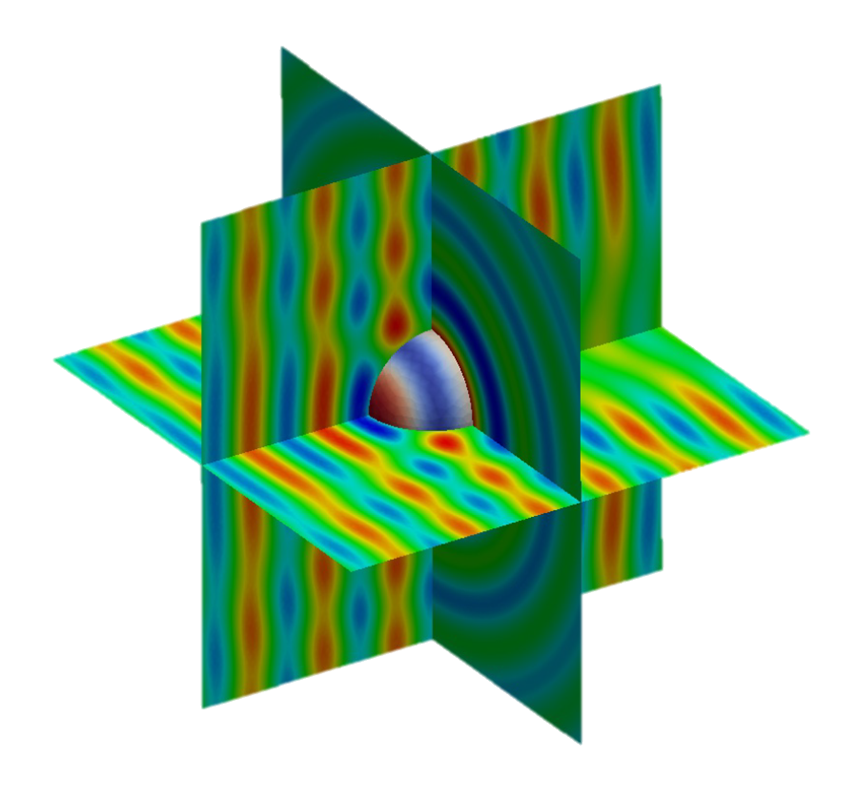3D Helmholtz problem using single layer potential integral equation#
XLiFE++ is also able to deal with integral equation. This example illustrates the computation of the acoustic scattering by a sphere:
\[\begin{split}\begin{cases}
\displaystyle \Delta u + k^2 u = 0 & \mathrm{\;in\;}\Omega=\mathbb{R}^3/B(0,R) \\
\displaystyle u=-u_{inc} & \mathrm{\;on\;} S
\end{cases}\end{split}\]
Using single layer potential leads to the integral equation:
\[\int_S G(x,y)p(y)dy = -u_{inc}\ \ \ \mathrm{\;on\;}S\]
where \(G\) is the Green function of the Helmholtz equation:
\[G(x,y)=\dfrac{e^{ik|x-y|}}{4\pi|x-y|}.\]
We deal with the variational formulation in \(V=H^{\frac{1}{2}}(S)\):
\[\mathrm{find\;} p \in V \mathrm{\;such\;that\;} \int_S \int_S p(y) G(x,y) \bar{q}(x) dx dy = -\int_S u_{inc} \bar{q} \quad \forall q\in V.\]
The solution \(u\) is got from potential \(p\) using the integral representation:
\[u(x)=\int_S G(x,y) p(y)dy.\]
This example has been implemented in XLiFE++ using a \(P^0\) Lagrange interpolation:
#include "xlife++.h"
using namespace xlifepp;
// incident plane wave
Complex uinc(const Point& p, Parameters& pa = defaultParameters)
{
Real kx=pa("kx"), ky=pa("ky"), kz=pa("kz");
Real kp=kx*p(1)+ky*p(2)+kz*p(3);
return exp(i_*kp);
}
int main(int argc, char** argv)
{
init(argc, argv, _lang=en); // mandatory initialization of xlifepp
// define parameters and functions
Parameters pars;
pars << Parameter(1., "k"); // wave number k
pars << Parameter(1., "kx") << Parameter(0., "ky") << Parameter(0., "kz"); // kx, ky, kz
pars << Parameter(1., "radius"); // sphere radius
Kernel G = Helmholtz3dKernel(pars); // load Helmholtz3D kernel
Function finc(uinc, pars); // define right hand side function
Function scatSol(scatteredFieldSphereDirichlet, pars); // exact solution
// meshing the unit sphere
Number npa=16; // nb of points by diameter of sphere
Sphere sp(_center=Point(0, 0, 0), _radius=1, _nnodes=npa, _domain_name="sphere");
Mesh mS(sp, _shape=triangle, _generator=gmsh);
Domain sphere = mS.domain("sphere");
// Lagrange P0 space and unknown
Space V0(_domain=sphere, _interpolation=P0, _name="V0", _notOptimizeNumbering);
Unknown u0(V0, _name="u0");
TestFunction v0(u0, _name="v0");
IntegrationMethods ims(_method=SauterSchwab, _order=3, _quad=symmetricalGauss, _order=3);
BilinearForm blf0=intg(sphere, sphere, u0*G*v0, _method=ims);
LinearForm fv0 = -intg(sphere, finc*v0);
// compute matrix and right hand side and solve system
TermMatrix A0(blf0, _storage=denseDual, _name="A0");
TermVector B0(fv0, _name="B0");
TermVector U0 = directSolve(A0, B0);
// integral representation on x plane (far from sphere), using P1 nodes
Number npp=20, npc=8*npp/10;
Real xm=4., eps=0.0001;
Point C1(0., -xm, -xm), C2(0., xm, -xm), C3(0., -xm, xm);
Rectangle recx(_v1=C1, _v2=C2, _v4=C3, _nnodes=npp);
Disk dx(_center=Point(0., 0., 0.), _v1=Point(0., 1.25, 0.), _v2=Point(0., 0., 1.25), _nnodes=npc);
Mesh mx0(recx-dx, _shape=triangle, _generator=gmsh);
Domain planx0 = mx0.domain("Omega");
Space Wx(_domain=planx0, _interpolation=P1, _name="Wx", _notOptimizeNumbering);
Unknown wx(Wx, _name="wx");
TermVector U0x0=integralRepresentation(wx, planx0, intg(sphere, G*u0), U0);
TermMatrix Mx0(intg(planx0, wx*wx), _name="Mx0");
// compare to exact solution
TermVector solx0(wx, planx0, scatSol);
TermVector ec0x0=U0x0 - solx0;
theCout << " L2 error on x=0 plane : " << sqrt(abs((Mx0*ec0x0) | ec0x0)) << eol;
// export solution to file
saveToFile("U0", U0, _format=vtu);
saveToFile("U0x0", U0x0, _format=vtu);
return 0;
}

Fig. 24 Solution of the 3D Helmholtz problem using single layer BEM on the unit sphere#
